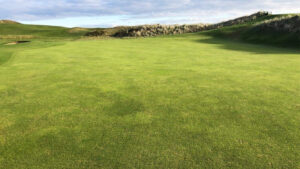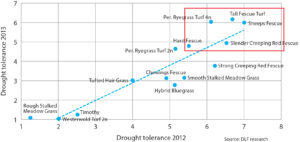With more droughts ahead, focus on fescues for fairways
Related Articles
With experts predicting droughts like what the UK experienced this summer are likely to become a more frequent occurrence, turf managers will be looking for ways to lessen the impact on their surfaces, while maintaining sward health and density during prolonged periods of hot and dry weather. Looking at golf courses in particular, many clubs have made significant steps forward since the last major drought, but what can they do now to further mitigate the impact in future? Stuart Yarwood, DLF’s regional technical manager, explores how drought-tolerant fescues are fundamental in effective fairway management.
The drought of 2018 taught us a lot. The perfect storm of prolonged, intense heat combined with extended drought conditions exposed weaker rooted areas of turf grass. Once the rains returned, these vulnerable areas lost out to pioneer species such as annual meadow grass, leading to longer-term weaker surfaces.
Whilst the native fescues successfully returned on fairways that fell foul to these hydrophobic ground conditions, the hangover was still visible at some courses around the country four years on, with the 2022 drought seeming even more intense. Many clubs have sensibly invested in upgrades to irrigation, utilised wetting agents and increased the frequency of aeration operations to improve rooting and moisture management but will still be performing important recovery overseeding over the next few months.
It is important to understand the effects of different types of drought. Spring droughts occur when, despite the lack of rain, water remains available in the deeper layers of soil meaning deeper rooting species like fescue are essential. Combine this with lower night temperatures and east winds, and the result is lower growth potential and stressed plants – emphasising the importance of correct, quality cultivar choice.
During a summer drought, even the deeper layers of the profile can run dry and the simultaneous higher temperatures mean the grass above ground has to be able to withstand dehydration from extended ET rates. In 2018 we lost grass as it was too hot for too long, and modern thinking went on to explore other species of fescue like Sheep’s and Hard in addition to established species such as Slender, Strong and Chewings.
Fescue, with its rolled, protected leaves and deep rooting, is likely to be the dominant species on most golf course fairways and therefore encouraging this would be considered best practice sustainably – especially with fescue being a versatile species, with hard-wearing properties, low nutritional requirements and producing an aesthetically-pleasing, drought-tolerant surface.
When selecting mixtures, consider species that cover the different growing properties you require. For example, with fescue, choose different cultivars that will deliver quality and performance across the board. Slender and Strong Creeping Red Fescues are extremely drought tolerant and are great for autumn recovery thanks to their creeping rhizomes that can help to regenerate worn areas. Chewings are visually attractive with good colour and grow in an upright nature. Sheep’s fescue is upright, drought resistant and ideal for closely mown areas that can dominate on poor soils, with Hard fescue also producing thick, upright leaves and dense growth.
Current research is also underway, analysing the correlation between increased hard fescue content leading to decreased leatherjacket / chafer grub activity.
There has been a swing in a lot of mixture formulations to include Sheep’s and Hard fescue because of their hard-wearing properties, low requirement for nutritional inputs and tolerance to a range of environmental stresses. However, supply can be limited as harvest yield can be commercially small compared to other species.
Thanks to DLF research, conducted at our RadiMax facility, we can ensure that only the best cultivars make it into mixtures – with drought tolerance testing (as shown in the graph) indicating that Slender, Hard and Sheep’s can all be grouped into the high tolerance category.
Reinforcing the benefits of a blend, most of the DLF mixtures available in the Johnsons Sports Seed range comprise a variety of fescue species for improved sward quality and sustainable management. Johnsons J Fescue is the leading greens’ fescue mix, combining three Slender and three Chewings fescue cultivars to create a high-quality sward that requires lower input of water and fertiliser. Supremely suited to fairways and tees, J Premier Fairway provides the ultimate formulation of Chewings, Slender, Strong, Sheep’s and Hard fescue – with four of the seven cultivars included topping the BSPB charts. Johnsons J Fairway is a sustainable blend of Chewings, Slender, Strong and Hard fescue and is top rated for visual merit and disease tolerance, while J Links is a pure rhizomatous Slender mix offering maximum drought recovery and excellent salt tolerance.
The key to getting the best from fescues is employing the correct husbandry. Good soil contact and soil temperature is key, and with temperatures holding much later into the calendar year, anytime up to November is great to incorporate fescues into your course. At this time, height of cut will be higher and drought and heat stress unlikely to affect newly germinated seedlings. As with most operations, be sure to communicate well with golfers and committees as to why this work is taking place and the benefits it will bring come the new playing season.
It is important to choose the right species and cultivars for your site, your agronomic direction and budget. Please also consider the commercial availability of grass seed mixes as demand for seed can peak through stressful times, seeing stocks run low.
Once the seed is in the ground, encourage deep rooting with low-disturbance, frequent slitting or verti-draining on the fairways when conditions allow, and targeted hollow coring on any particularly compacted or problematic areas. If budgets permit, utilise seaweed tonics and penetrants on the fairways over the winter to maximise moisture movement through the profile, thus restoring moisture to hydrophobic areas.
If fairways are de-compacted, enjoy adequate nutrient and moisture levels, and good agronomic husbandry then, with traffic managed, fescues will naturally flourish. The technical team at DLF / Johnsons can help you to understand how the incorporation of fescues fits into the broader operations and management of the course, and together with observing the impact of the 2018 and 2022 droughts on your site, can help to create a plan to successfully guide courses through future climate change – whatever the weather may bring.
For more information visit www.johnsonssportsseed.co.uk



























